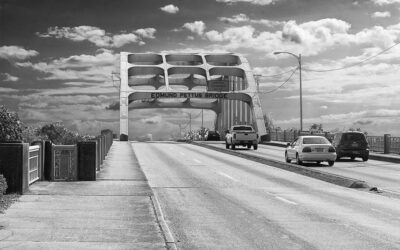I stood frozen with fear, unable to run. The terrifying image drew closer, his curved sword swinging wildly. Just as he was about to separate my head and body, I snapped back to reality, left my all-too-real daydream about Blackbeard behind and moved on the next exhibit in the museum.
The story of Blackbeard the Pirate is but one display that makes the Graveyard of the Atlantic Museum in Hatteras, North Carolina, fascinating. That eclectic collection is among numerous attractions which transform the Outer Banks – the chain of narrow barrier islands that parallels the state’s Atlantic coastline – into much more than just another sun-and-sand vacation destination.
Stretches of broad beach and sand dunes, interspersed by marshes and pockets of woodland, comprise the barrier islands. They’re also home to an inviting variety of intriguing attractions that can fill many a day of activity and sightseeing.
The Outer Banks began attracting vacationers in the 1830s, when families of wealthy North Carolina planters found refuge there from the summer heat . They were followed by sportsmen drawn by the outstanding fishing and hunting that Native Americans had discovered centuries earlier.
The same attributes continue to attract many visitors. Of course, beaches along the 130-mile-long Outer Banks remain the major summer draw for most folks. Cape Hatteras National Seashore covers much of the Banks. Stretching over 70 miles, this near-pristine enclave encompasses some of the largest areas of undeveloped beaches in the United States.
Drivers heading south on state highway 12 have opportunities to check out villages along the way. In addition to similarities as oceanfront vacation towns, some have unique characteristics. Many visitors rate Corolla (pronounced coh-RAH-luh) and Duck, the northernmost towns, as the two prettiest on the islands. Both have a small-town atmosphere, good restaurants and a number of rambling houses that would feel at home in an upscale neighborhood anywhere.
Duck is perfect for strolling. A new wooden boardwalk follows the water along the west side of town, in some places passing woods where bird calls are the only sound, in other spots leading to locally owned boutiques and galleries.
Kitty Hawk, Kill Devil Hills and Nags Head form the commercial hub of the Outer Banks. Along with a strip-mall atmosphere there are two major attractions. It was at Kitty Hawk where, on December 17, 1903, Wilbur and Orville Wright made the first controlled power flights, the longest lasting 59 seconds and covering 852 feet. A museum houses a full-scale replica of their craft and a wealth of other treasures.
Nearby Jockey’s Ridge State Park contains the tallest sand dunes on the east coast. In this mini-desert setting, winds reshape the sand, causing the dune for which the park is named to vary in height from 80 to 100 feet.
South of the commercial section of the Outer Banks, both traffic and the islands thin. The road passes through several miniscule towns and, just past Hatteras village, ends at a ferry dock. Along the way are more opportunities to check out enticing attractions.
Several chapters of history spring to life on Roanoke Island, the site of the first English colony in the New World. I began my exploration at Festival Park, where the life of Native Americans who originally inhabited the area is recreated. Longhouses, a dance circle, and planting and harvesting areas set the mood. Interactive exhibits scattered about interest generations of family visitors.
To relive the next chapter of the past, clamber aboard the Elizabeth II, a sailing ship representative of the seven British vessels that arrived during the 16th century. Costumed interpreters spin tales of perilous voyages in a brogue that echoes the speech of that time.
The history lesson continues at the Roanoke Adventure Museum, where 400 years of the Outer Banks’ past are explored. From early pirates to the Civil War, from boat-building to shipwrecks, virtually every facet of life as it used to be gets its due.
The most famous attraction on Roanoke Island is the Lost Colony, a something-for-everyone drama with special effects, daring action, comedy, music and dance. It relates the true story of the disappearance – no one knows where or why – of 116 men, women and children who settled in the New World in 1587.
Even this list does not exhaust the possibilities. The Graveyard of the Atlantic Museum in Hatteras village tells the story of more than 2,000 known shipwrecks that lie in waters off the Outer Banks. Many went down in the 18th and 19th centuries, victims of dangerous currents, shoals and storms. Others were cargo vessels heading to England that were sunk by German submarines lurking off our country’s east coast during World War II. Parts of several shipwrecks are visible today on beaches or in shallow water at low tide. Other well-done exhibits at the museum deal with pirates, including the notorious Blackbeard who was killed in the area.
Lighthouse buffs will think they’ve gone to heaven. Four towers mark the Outer Banks, two of which are open from spring to fall for those who wish to climb to the top.
If climbing the 257 steps of the Cape Hatteras Lighthouse isn’t your idea of enjoyable exercise, there’s always hiking and hang gliding, kayaking and kite boarding, fishing and crabbing, sailing and surf boarding. Oh yes, and one of my favorite beach pastimes: relaxing on some of the finest sand anywhere with a good book.
For information about visiting the Outer Banks, call 877-629-4386 or log onto outerbanks.org.

After gallivanting throughout the United States and to more than 75 other countries around the world, and writing about what he sees, does and learns, Victor Block retains the travel bug. He firmly believes that travel is the best possible education, and claims he still has a lot to learn. He loves to explore new destinations and cultures, and his stories about them have won a number of writing awards.




